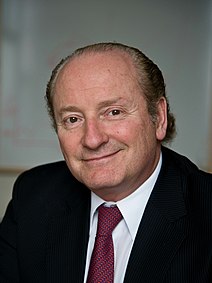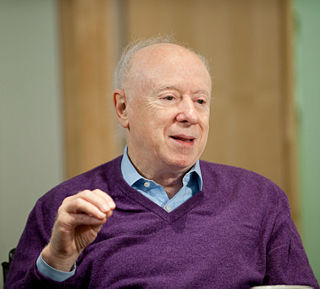
The Fields Medal is a prize awarded to two, three, or four mathematicians under 40 years of age at the International Congress of the International Mathematical Union (IMU), a meeting that takes place every four years.

Robert Cox Merton is an American economist, Nobel Memorial Prize in Economic Sciences laureate, and professor at the MIT Sloan School of Management, known for his pioneering contributions to continuous-time finance, especially the first continuous-time option pricing model, the Black–Scholes–Merton model. In 1993 Merton co-founded hedge fund Long-Term Capital Management.

The Royal Society of Edinburgh is Scotland's national academy of science and letters. It is a registered charity, operating on a wholly independent and non-party-political basis and providing public benefit throughout Scotland. It was established in 1783. As of 2017, it has more than 1,660 Fellows.

The Shaw Prize is an annual award first presented by the Shaw Prize Foundation in 2004. Established in 2002 in Hong Kong, it honours
"individuals who are currently active in their respective fields and who have recently achieved distinguished and significant advances, who have made outstanding contributions in academic and scientific research or applications, or who in other domains have achieved excellence. The award is dedicated to furthering societal progress, enhancing quality of life, and enriching humanity's spiritual civilization."

Joseph Leonard Goldstein ForMemRS is an American biochemist. He received the Nobel Prize in Physiology or Medicine in 1985, along with fellow University of Texas Southwestern researcher, Michael Brown, for their studies regarding cholesterol. They discovered that human cells have low-density lipoprotein (LDL) receptors that remove cholesterol from the blood and that when LDL receptors are not present in sufficient numbers, individuals develop hypercholesterolemia and become at risk for cholesterol related diseases, notably coronary heart disease. Their studies led to the development of statin drugs.

The Australian Academy of Science was founded in 1954 by a group of distinguished Australians, including Australian Fellows of the Royal Society of London. The first president was Sir Mark Oliphant. The Academy is modelled after the Royal Society and operates under a Royal Charter; as such, it is an independent body, but it has government endorsement. The Academy Secretariat is in Canberra, at the Shine Dome.
Sir Peter James Donnelly is an Australian mathematician and Professor of Statistical Science at the University of Oxford, and the CEO of Genomics PLC. He is a specialist in applied probability and has made contributions to coalescent theory. His research group at Oxford has an international reputation for the development of statistical methodology to analyze genetic data.

Richard Henderson is a Scottish molecular biologist and biophysicist and pioneer in the field of electron microscopy of biological molecules. Henderson shared the Nobel Prize in Chemistry in 2017 with Jacques Dubochet and Joachim Frank.
John Anthony Hardy FRS is a human geneticist and molecular biologist at the Reta Lila Weston Institute of Neurological Studies at University College London with research interests in neurological diseases.
The Whitehead Prize is awarded yearly by the London Mathematical Society to multiple mathematicians working in the United Kingdom who are at an early stage of their career. The prize is named in memory of homotopy theory pioneer J. H. C. Whitehead.

Hugh Phillip Possingham, FAA, is Chief Scientist of The Nature Conservancy, best known for his work in conservation biology. He is also an ARC Laureate Fellow in the Department of Mathematics and the School of Biological Sciences at the University of Queensland.
The David Syme Research Prize is an annual award administered by the University of Melbourne for the best original research work in biology, physics, chemistry or geology, produced in Australia during the preceding two years, particular preference is given to original research to enhance industrial and/or commercial development.

Peter Gavin Hall was an Australian researcher in probability theory and mathematical statistics. The American Statistical Association described him as one of the most influential and prolific theoretical statisticians in the history of the field. The School of Mathematics and Statistics Building at The University of Melbourne was renamed the Peter Hall building in his honour on 9 December 2016.
Christopher Charles Heyde AM was a prominent Australian statistician who did leading research in probability, stochastic processes and statistics.
The Berwick Prize and Senior Berwick Prize are two prizes of the London Mathematical Society awarded in alternating years in memory of William Edward Hodgson Berwick, a previous Vice-President of the LMS. Berwick left some money to be given to the society to establish two prizes. His widow Daisy May Berwick gave the society the money and the society established the prizes, with the first Senior Berwick Prize being presented in 1946 and the first Junior Berwick Prize the following year. The prizes are awarded "in recognition of an outstanding piece of mathematical research ... published by the Society" in the eight years before the year of the award.
The Hannan Medal in the Mathematical Sciences is awarded every two years by the Australian Academy of Science to recognize achievements by Australians in the fields of pure mathematics, applied and computational mathematics, and statistical science.
The Pawsey Medal is awarded annually by the Australian Academy of Science to recognize outstanding research in the field of physics by an Australian scientist under 40 years of age.
The William Bate Hardy Prize is awarded by the Cambridge Philosophical Society. It is awarded once in three years “for the best original memoir, investigation or discovery by a member of the University of Cambridge in connection with Biological Science that may have been published during the three years immediately preceding”.
The Cherry Kearton Medal and Award is an honour bestowed by the Royal Geographical Society on "a traveller concerned with the study or practice of natural history, with a preference for those with an interest in nature photography, art or cinematography". It is named for nature photographer Cherry Kearton and was launched in 1967.








